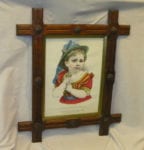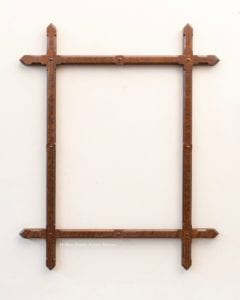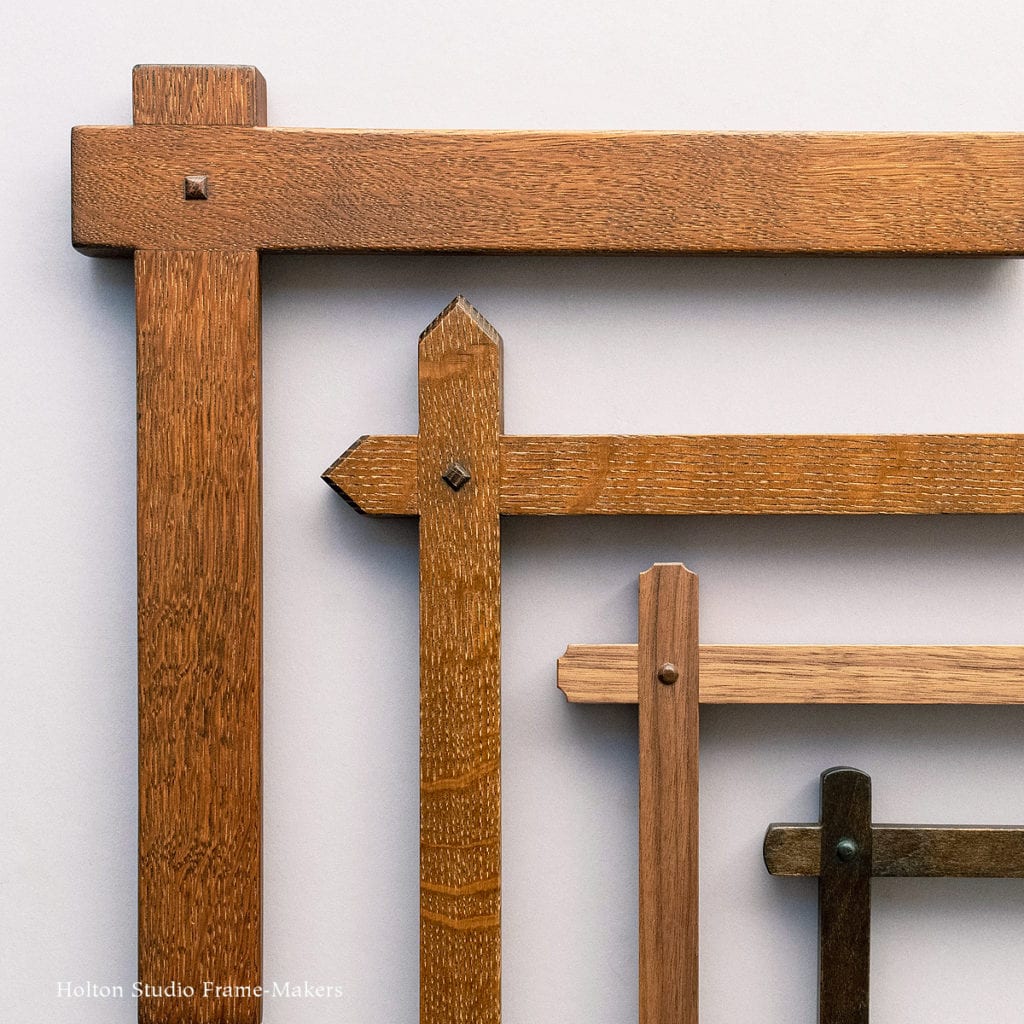For many years we’ve offered a simple lap-joined frame we call the Adirondack. Now we’re expanding on that design with more decorative variations we’re calling “Oxford Frames”—the traditional name for the frame of this general type first popularized in Victorian England. View the extensively updated page here…
The Oxford English Dictionary defines the Oxford frame as, “A picture-frame the sides of which cross each other and project some distance at the corners.” Sometimes described by frame-makers and frame scholars as crossetted-corner frames, on these shores they were popularly called Rustic or Currier and Ives frames, often favored as settings for prints by enormously popular printmakers Currier and Ives (an example’s shown at right). It’s a wonderfully varied vernacular tradition with unlimited possibilities for decorative treatment.
Structurally identical to the Adirondack, when developing it into the Oxford, we started with modifying the Adirondack’s blunt-cut ends in the simplest possible ways, giving them, for example, rounded and pointed forms. An example is the inner frame in the picture below. To offer some idea of the kind of elaboration possible, we also made an example of a fancier Oxford design, the outer frame shown in the picture below (offered as a ready-made 14″ x 18″, ) which demonstrates the kind of chamfering characteristic of the tradition. As you can see, we also accented the center of each side by stopping the chamfers with 45 degree angle cuts to create an octagon with a diagonal inlaid square plug in the middle, repeating those at the corners.
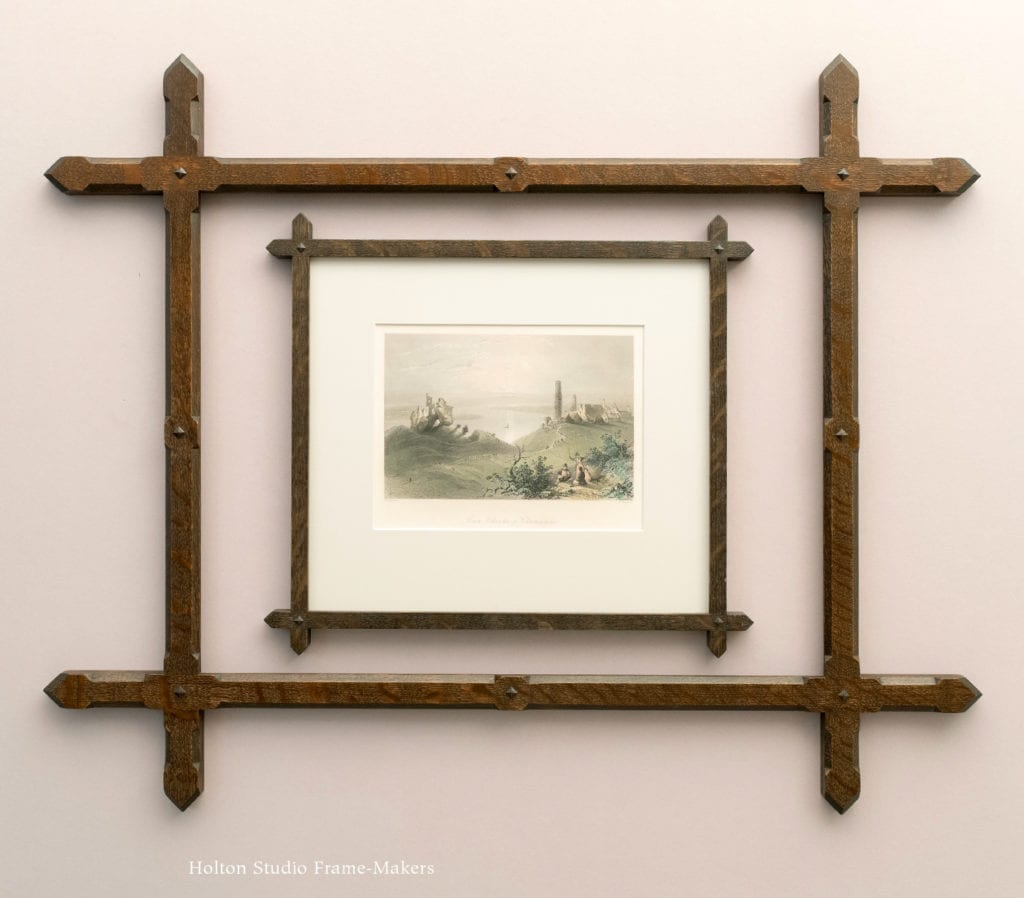
A vintage colored engraving of the Irish monastic ruins of Clonmacnoise in a simple Oxford frame, surrounded by a more elaborate Oxford frame using chamfering (45 degree bevels)—a method of decorative enhancement characteristic of the tradition. Both frames are in stained quarter sawn white oak, the wood most commonly used for Oxford frames.
There is a very good introduction to Oxford frames on the National Portrait Gallery website’s section called The Art of the Picture Frame, run by Jacob Simon and based on his definitive book by that title. “Oxford frames were often used in domestic settings for framing prints and watercolours,” the page notes. “The Oxford frame was popular for framing prints and reproductions in the late nineteenth century. It first became common in the 1860s but its introduction remains obscure. The earliest identified reference comes in an advertisement in 1864, offering an oak Oxford frame for an image of the Nativity (Illustrated London News, 14 January 1864, p.62).”
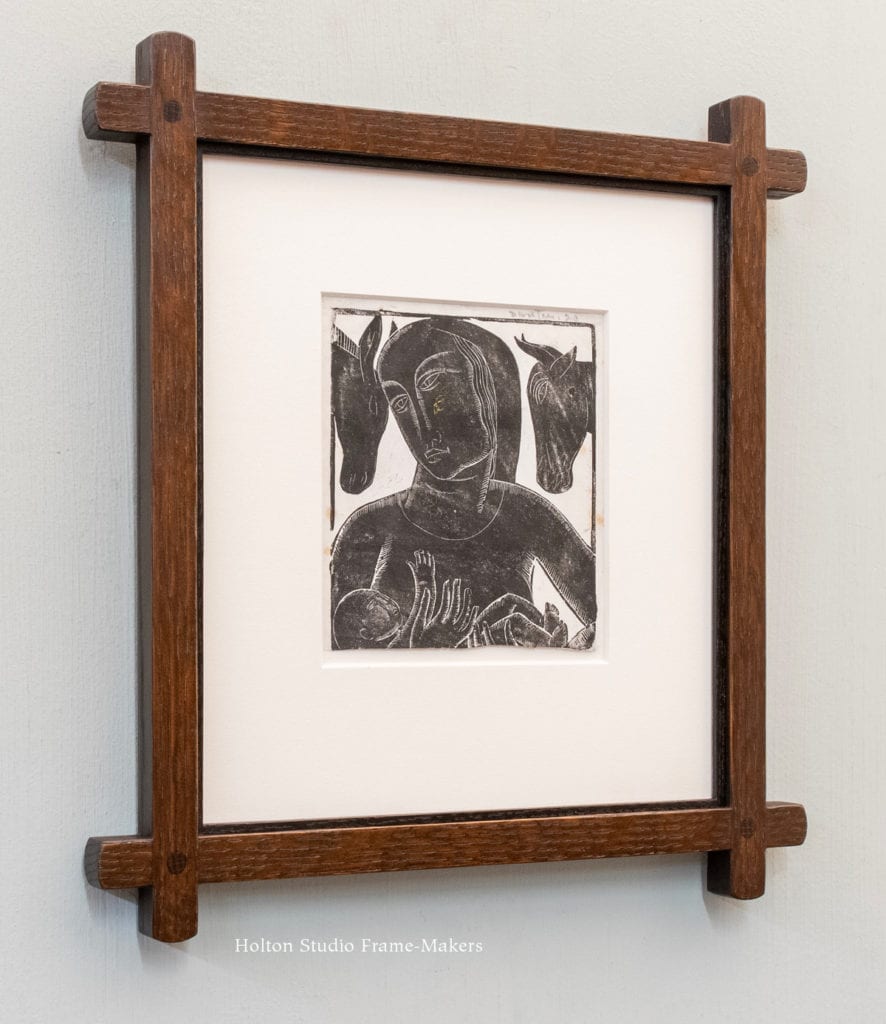 The crosses formed by the corners clearly appealed to Christian believers. “It would appear,” Jacob Simon’s webpage says, “that Oxford frames, with their corners crossed in a similar manner to the ‘Oxford’ corners used by printers, took their name from their association with publications of the Oxford Movement,” a mid-nineteenth century High Church movement associated with Oxford University and calling for the reinstatement to the Church of England of some older Christian traditions. It’s not surprising, therefore, to find that in 1877, Charles Savory in The Practical Carver and Gilder’s Guide identified Oxford frames as having grown popular as “suitable for sacred subjects, mottoes, [and] views in the Holy Land.” The Christian association of these frames rendered them suitable, then, for two prints we recently framed, and shown here. The one at left, a Madonna and child by British artist and poet David Jones (1895-1974), is in a 1/2″ stained oak Oxford frame with black slip; the one in the picture above is a nineteenth century print of the ruins of the medieval Irish monastery Clonmacnoise. “But,” Savory goes on to say, Oxford frames “are [also] used for portraits, and many other pictures look well in them.” Their general popularity is suggested by the fact that, according to Savory, they were manufactured in eleven standard sizes from 4 1/4 by 3 1/4 inches to 29 by 21 inches.
The crosses formed by the corners clearly appealed to Christian believers. “It would appear,” Jacob Simon’s webpage says, “that Oxford frames, with their corners crossed in a similar manner to the ‘Oxford’ corners used by printers, took their name from their association with publications of the Oxford Movement,” a mid-nineteenth century High Church movement associated with Oxford University and calling for the reinstatement to the Church of England of some older Christian traditions. It’s not surprising, therefore, to find that in 1877, Charles Savory in The Practical Carver and Gilder’s Guide identified Oxford frames as having grown popular as “suitable for sacred subjects, mottoes, [and] views in the Holy Land.” The Christian association of these frames rendered them suitable, then, for two prints we recently framed, and shown here. The one at left, a Madonna and child by British artist and poet David Jones (1895-1974), is in a 1/2″ stained oak Oxford frame with black slip; the one in the picture above is a nineteenth century print of the ruins of the medieval Irish monastery Clonmacnoise. “But,” Savory goes on to say, Oxford frames “are [also] used for portraits, and many other pictures look well in them.” Their general popularity is suggested by the fact that, according to Savory, they were manufactured in eleven standard sizes from 4 1/4 by 3 1/4 inches to 29 by 21 inches.
But factories were by no means the only makers of Oxford frames. Smaller workshops contributed significantly to the tradition. Oxford frames “of late years have been deservedly in high favour among amateur frame-makers,” wrote James Lukin in 1882 in his book, Picture Frame making for Amateurs, which includes a chapter on how to make them. Another period guide for amateur frame-makers, also covering Oxford frames (and available online), is Mounting and Framing Pictures, by Paul Hasluck, 1899. We can presume that in between the factories and amateur shops were small professional frame-makers contributing to the genre.
Typically made of oak (largely due, no doubt to its Medieval, i.e., pre-Reformation, associations), Oxford frames and their derivatives were made out of other woods as well, including walnut, as in the Currier and Ives frame at the top of this post.
View the page, “Adirondack & Oxford (Lap-Joined) Frames”…
« Back to Blog
